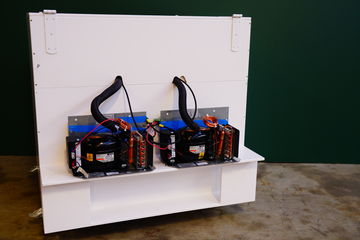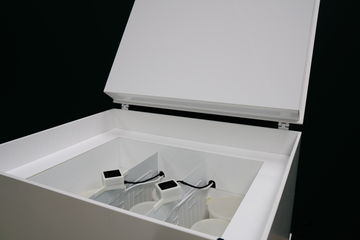Click here to register!
Difference between revisions of "Energy input in the Maize value chain in Benin"
***** (***** | *****) |
***** (***** | *****) |
||
| Line 19: | Line 19: | ||
Smallholder farmers usually do the land preparation and plant production manually, medium-sized farms commonly request the services concerning machinery for land preparation and equipment with or without operator. Large farms usually own the tractors for the cultivation of their crops. | Smallholder farmers usually do the land preparation and plant production manually, medium-sized farms commonly request the services concerning machinery for land preparation and equipment with or without operator. Large farms usually own the tractors for the cultivation of their crops. | ||
| + | |||
| Line 26: | Line 27: | ||
During the clearing of the fields, bushes and shrubs are cut down manually and removed/burned by workers equipped with machetes. The ploughing is done either manually by farmers equipped with hoes or mechanized with the help of tractors.<br/> | During the clearing of the fields, bushes and shrubs are cut down manually and removed/burned by workers equipped with machetes. The ploughing is done either manually by farmers equipped with hoes or mechanized with the help of tractors.<br/> | ||
| − | The following table shows the labour inputs, when the field preparation activities are done manually. The number of farms indicate on how many farms the data were collected. Labour inputs gives the mean value (and standard deviation) of the total labour of one person required to prepare a field size of one hectare. | + | The following table shows the labour inputs, when the field preparation activities are done manually. The number of farms indicate on how many farms the data were collected. Labour inputs gives the mean value (and standard deviation) of the total labour of one person required to prepare a field size of one hectare. |
{| class="wikitable" style="margin-left: auto; margin-right: auto; border: none" | {| class="wikitable" style="margin-left: auto; margin-right: auto; border: none" | ||
| Line 44: | Line 45: | ||
|} | |} | ||
| + | <br/> | ||
| − | + | The following table shows the amount of fuel required and the respective machine time for the mechanized ploughing of one hectare by tractor.<br/> | |
| − | The following table shows the amount of fuel required and the respective machine time for the mechanized ploughing of one hectare by tractor. <br/> | ||
{| class="wikitable" style="margin-left: auto; margin-right: auto; border: none" | {| class="wikitable" style="margin-left: auto; margin-right: auto; border: none" | ||
| Line 62: | Line 63: | ||
<br/> | <br/> | ||
| + | |||
| + | <br/> | ||
| + | |||
| + | <br/> | ||
| + | |||
| + | [[File:Example System 1 - Overview.JPG|thumb|left|360px|Example System 1 for ice production|alt=Example System 1 - Overview.JPG]] [[File:Example System 1 - Cooling units.JPG|thumb|right|360px|Cooling units in the back the system|alt=Example System 1 - Cooling units.JPG]]<br/><br/>[[File:Smart Ice Maker Inside view.JPG|thumb|left|360px|Inside view of system|alt=Smart Ice Maker Inside view.JPG]][[File:Fans within the smart ice maker.JPG|thumb|right|360px|Fans in the system for better heat transfer|alt=Fans within the smart ice maker.JPG]] | ||
Revision as of 16:51, 23 January 2020
Introduction
Maize production
Worldwide, maize (Zea mays l.) is the most widely cultivated crop with a production of over a billion tons per year and is therefore of very high importance for global food security and livelihoods, especially in developing countries. According to Leroux et al. (2019), maize is the leading staple food in West African countries with a yearly consumption of more than 30 kg/capita. From 2007-2016, yields of rainfed maize systems in Sub Saharan Africa (SSA) range between 1.68 to 1.99 t/ha, which is 15-25% of the yield potential for water-limited production (ten Berge et al., 2019). Maize can be prepared in different forms which include whole-maize foods, porridges or beverages (Ekpa et al., 2018). In, maize is the most important staple food and the most cultivated crop, with 85% of farmers growing it. The area devoted to maize production is about one-third of the total agricultural area in Benin (Amegnaglo, 2018).
Energy conversion factors
Maize value chain in Benin
Maize production has different processing steps, most of them are performed sequentially. Maize production starts with activities of land preparation, where fields are prepared for the planting. The activities of plant production include the processes from planting to harvest. Postharvest activities are the processing steps until reaching the final product.
Smallholder farmers usually do the land preparation and plant production manually, medium-sized farms commonly request the services concerning machinery for land preparation and equipment with or without operator. Large farms usually own the tractors for the cultivation of their crops.
Land preparation
During the clearing of the fields, bushes and shrubs are cut down manually and removed/burned by workers equipped with machetes. The ploughing is done either manually by farmers equipped with hoes or mechanized with the help of tractors.
The following table shows the labour inputs, when the field preparation activities are done manually. The number of farms indicate on how many farms the data were collected. Labour inputs gives the mean value (and standard deviation) of the total labour of one person required to prepare a field size of one hectare.
| Process |
Number of farms |
Labour inputs (Man-hour/ha) |
|---|---|---|
| Manual clearing |
12 |
137.9 (± 84.2) |
| Manual ploughing |
7 |
181.1 (± 85.2) |
The following table shows the amount of fuel required and the respective machine time for the mechanized ploughing of one hectare by tractor.
| Process | Number of observations | Fuel (l/ha) | Machine time (h/ha) |
|---|---|---|---|
| Mechanized ploughing |
2 |
13.1 (± 4.9) |
2.3 (± 1.1) |
Plant production
Postharvest
Cropping calendar
Energy input
Greenhouse gas emissions























